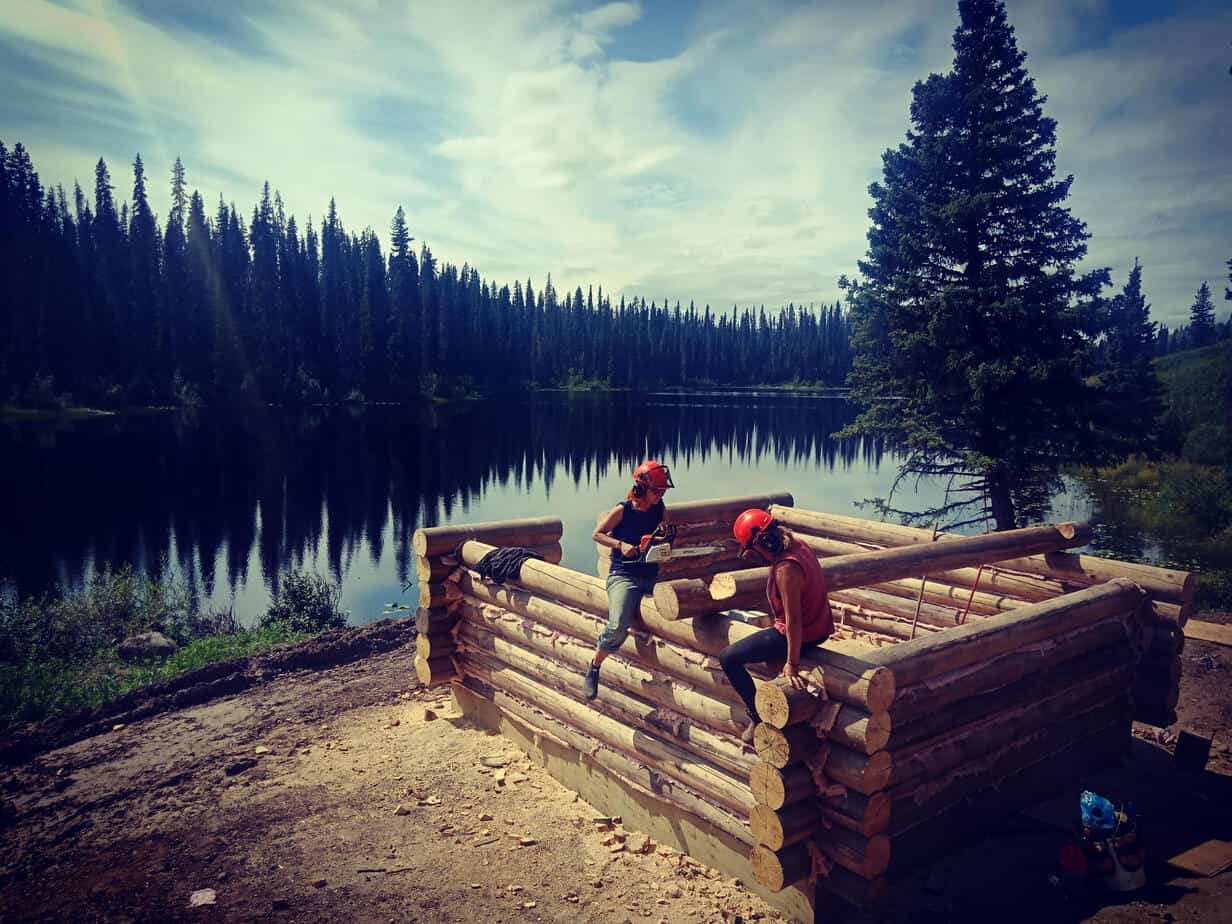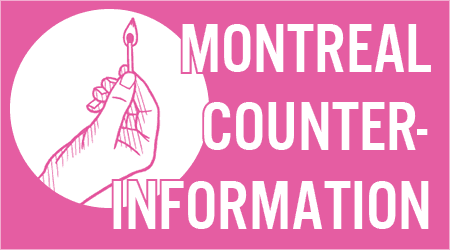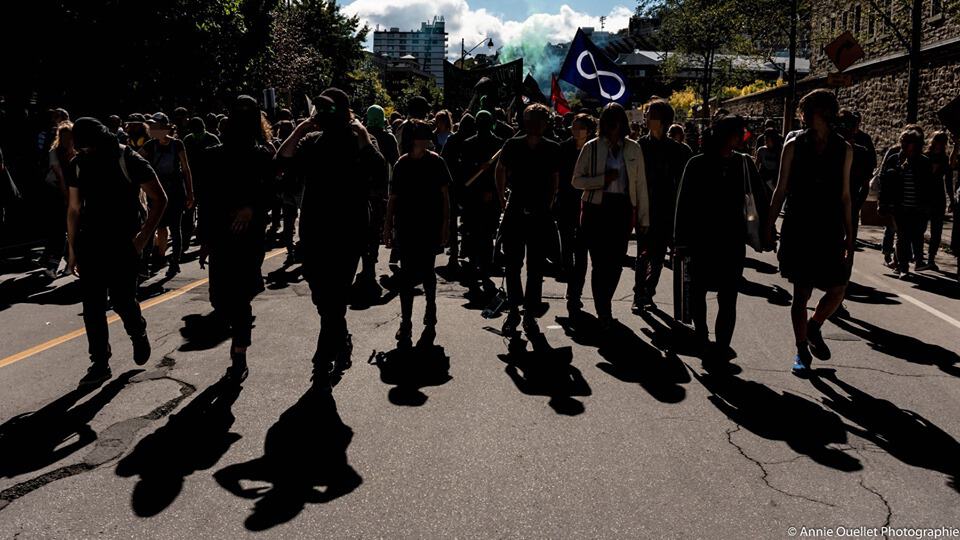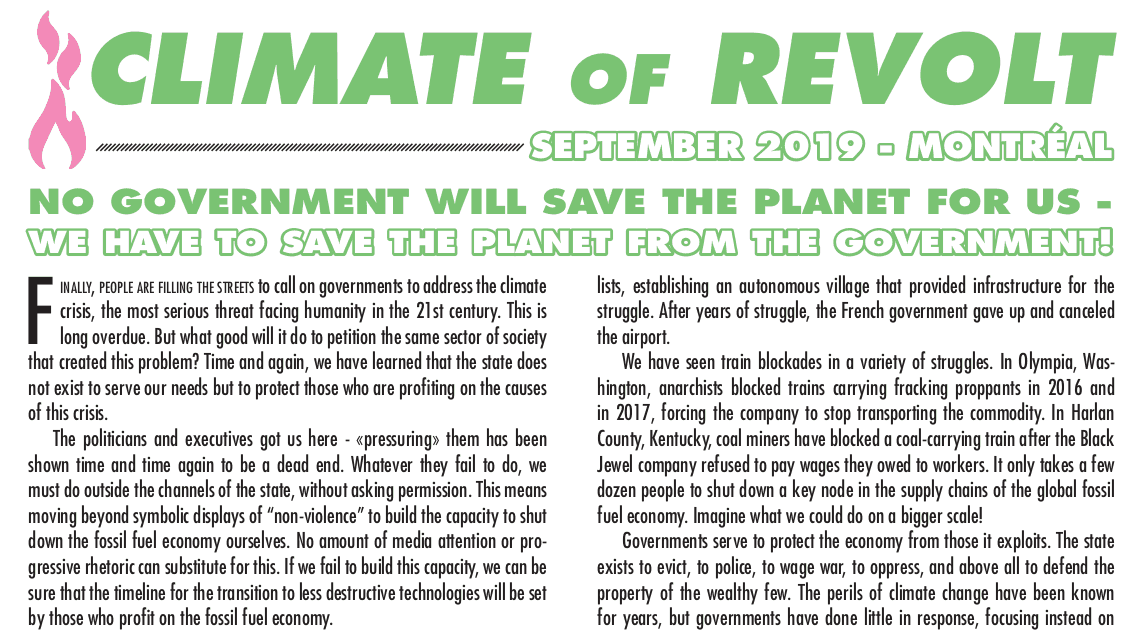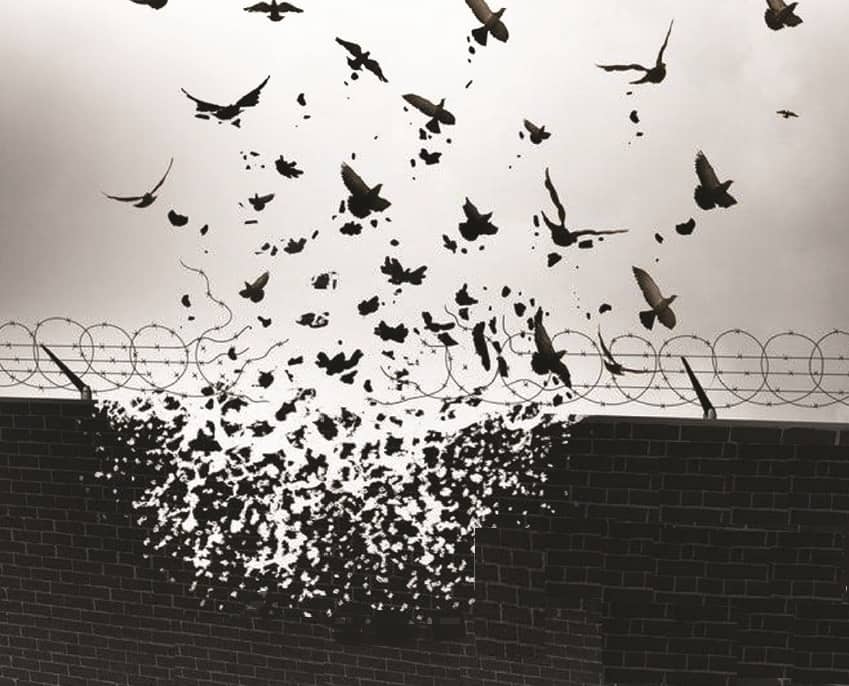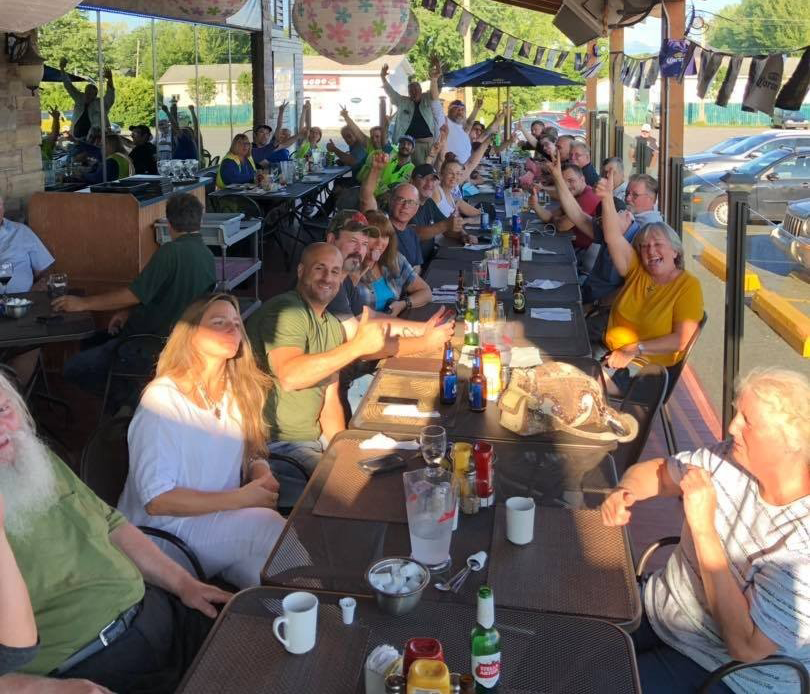Definitions and Characteristics
As an organization that initially emerged out of experiences activists had trying to shut down far right demonstrations and events in Montreal, Montréal Antifasciste has focused on movements and organizations that promote exclusionary beliefs and policies more drastic than the “mainstream” right-wing agenda. This is obviously not a theoretically rigorous approach, just a pragmatic one, and we are aware that there are many circumstances where it might not be appropriate. Furthermore, for reasons having as much to do with capacity as anything else, we have not publicly targeted movements that currently engage in little or no public activities in our city – for instance, the anti-abortion movement or the broader Catholic Right – even though we try to keep them on our radar.
It must be stressed – our focus is a matter of expediency, we do not suggest that it should be adopted by the left overall. We recognize that State policies (like Law 21) and practices (such as police violence and border controls), as well as broader systems of oppression, have a far greater impact than the far right does on its own. Nonetheless, we feel that small focused groups can have a disproportionate effect on wider systems, and that even when they do not they still represent a threat that must be dealt with on its own terms –that’s the task we have taken as our own.
A thorough cartography of the Quebec far right would be the length of a small book; what follows is a rough outline. Our priority will be to explain the characteristics of this terrain and identify some of the more important groups, however we are aware that there is a lot we are leaving out due to simple space constraints. We encourage interested readers to check out our website (http://montreal-antifasciste.info) for a more detailed and extensive examination.
While some of us have been active studying and opposing the far right for decades, our work as MAF has been practical, and practice has shaped both what we have been able to learn and how we have come to understand the situation. Based on this experience, we have found the core beliefs of the contemporary far right in Quebec to be:
- Islamophobia;
- opposition to a simplistically outlined “global system” identified most closely with the provincial and federal Liberal Parties (and personified for many people by Justin Trudeau, who is personally vilified, mocked for being a dunce, and accused of everything from being Fidel Castro’s son to supporting pedophilia and Sharia law in Canada).
- belief that a process is underway by which specific groups of people the far rightists identify with (“old stock Québécois”, “white people”, etc.) are going to be replaced by people of different cultures and/or “races” (the extent to which this replacement is explicitly planned, and by whom, varies within and between groups).
Beyond these points that unite the entire far right, there are a number of differences, the most important one being between a much larger and less politically coherent body of activists who share many attributes with the “mainstream right,” and a smaller tendency with more ideologically rigorous positions which explicitly draw on historical fascism and overt white supremacy. In our work we have termed the former milieu “national populists,” whereas we have referred to the latter as “fascists,” “neofascists,” or even “neo-nazis,” as the case may be.
From what we can tell, in both their core beliefs and the political bifurcation we have described, the Quebec far right is staying true to patterns that exist across Canada.
The main national-populist organizations in Quebec are La Meute (founded in 2015) and Storm Alliance (founded in 2016). Whereas the former initially focused on opposition to “radical Islam” and the latter on “illegal immigration,” they are currently indistinguishable in their opposition to both. The much smaller and marginal Front patriotique du Québec has also played an important part in the milieu in a variety of ways; it has repeatedly raised criticisms of La Meute for being “federalist,” and at the same time several of its members or sympathizers have been instrumental in setting up far right “security” groups whose goal is to intimidate their opponents and protect their organizations. Finally, one must mention the so-called Vague bleue mobilization which occurred in Montreal on May 4 of this year, with a second one being held in Trois-Rivières on July 27. Adopting an approach developed by the FPQ, these gatherings have been organized by national populists but have brought together people unaware of the politics involved, together with far-right security groups and even neofascists. While the “Vague bleue 2” was a horrible failure (from 300 participants in Montreal, the numbers were down to 75 in Trois Rivières), the formula of organizing such events will likely be tried again.
The neofascist tendency is much “tighter” than the national-populist milieu, and there are currently only two organizations of note: Atalante (based in Quebec City and active since 2016) and the Fédération des Québécois de souche (decentralized, albeit with a hub in Saguenay, and active since 2007). At the same time, there have been a number of semi-formal and secretive political initiatives by neofascists and neo-nazis over the years; perhaps the most important recent example being the Alt-Right Montreal/Montreal Stormers group whose existence was revealed by The Montreal Gazette in May 2018. All of the groups in this tendency explicitly identify with the traditions of fascism and open white nationalism.
The National-Populist Milieu
The appearance of La Meute (and to a lesser extent Storm Alliance) signaled an important change in the Quebec far right. These were the first groups since the 1990s that were visibly able to speak to a base beyond their actual membership; in other words, they were the first groups with any real potential for growth. Groups that had been active before them –the Order of Templars, PEGIDA Québec, the Concerned Citizens’ Coalition, the Mouvement Républicain du Québec, etc. – never amounted to more than a few individuals (sometimes just one lone individual) claiming to be an “organization.” The one group that had a certain following that existed prior to 2016 – Les Insoumis – never managed to extend their group beyond the Sherbrooke area, though some members did repeatedly travel to Montreal to participate in other groups’ events. The closest thing we can see to a portent of what was to come was the “Marche du Silence” held in Montreal on September 24, 2015, against the PLQ’s Bill 52 (which was attended by Les Insoumis and certain anti-immigration activists), although various mass demonstrations in favour of the PQ’s Charte des valeurs québécoises in 2013 did serve as earlier warning signs.
The national-populist milieu contains a diversity of views on various questions, this being sanctioned by a frequently voiced desire to privilege “unity” by accepting people with different opinions, so long as they agree with the (rarely explained) “cause”. As a result, this milieu is far less coherent, but also much larger and more potentially mutable, than the neofascist right. To counter the tendency to describe all far right groups as “fascist”, it is worth going over some of the specific attributes of the national-populist milieu:
- Many national populists insist they are not racist, and opposition to racial discrimination is a part of the official policy of La Meute and Storm Alliance. While this rests on the spurious assertion that “Islam is not a race,” many sincerely believe this, and this is something that distinguishes them from others on the far right. This opens the door to a situation where a certain number of people of colour, former Muslims, and Indigenous people are welcomed at national-populist mobilizations (albeit in often cringe-inducing tokenizing ways). This also makes these groups more palatable to a section of white society which may be racist but which is uncomfortable claiming this identity openly.
- Significant sections of the national-populist movement are taken with homonationalist and femonationalist themes, and as such identify with an ideal of a Quebec that would remain anathema for others on the far right. “Radical Islam” and “illegal immigrants” are opposed in terms of the rights of women and LGB people (though pointedly not in terms of trans people’s rights), even in terms of “feminism.” With few exceptions, members of this milieu will claim to be for women’s rights (this is official policy on the part of both La Meute and Storm Alliance), and opposing misogynist practices is one of the most popular anti-Muslim tropes. Furthermore, there are many women active in the movement, several of whom hold positions of authority and power. At the same time, the movement remains dominated by men; besides reports of sexual assault and harassment among members, a brief survey of social media accounts shows a wide range of memes, jokes, and comments that many would consider sexist and/or sexually objectifying, and the top leadership remains overwhelmingly male.
- The milieu is not united behind a single position regarding Quebec independence. While it includes few if any hardcore federalists, the spectrum of opinion ranges from hardcore support for independence (FPQ and the recently formed Parti Patriote) to a position that these questions are secondary and that both Canada and Quebec need to be defended from “illegal immigrants”/“radical Islam” (La Meute, Storm Alliance). This has been the cause of numerous conflicts between individuals, and has played into conflicts between groups, for instance with accusations that La Meute is “federalist.”
- The national-populist milieu overwhelmingly considers itself sympathetic to Indigenous people, who are viewed as victims of the same system victimizing Québécois and Canadians. There is also the position, shared even by some neofascists, that contemporary movements should build upon a historic alliance between French Canadians and Indigenous people against the English. This is based on a superficial and self-serving version of Quebec history that denies any role of French Canadians in the colonization and genocide of the First Nations, parallel with an appropriative view of “all Québécois” somehow being “Indigenous” due to purported “Indigenous ancestry,” leading to a conclusion that there are no wrongs that need to be redressed, simply an alliance against the “globalists” (or the Liberals, or the invaders, etc.) that needs to be forged. Nonetheless, Indigenous individuals have repeatedly been welcomed at national-populist mobilizations, often flying the Mohawk Warrior/Unity flag for instance, and there have been multiple (failed) attempts to forge connections with Indigenous communities. It should be noted that this appears to be as superficial as it is self-serving – when faced with actual Indigenous claims of sovereignty or possession of land, many national populists quickly slide back into predictably reactionary positions.
- Antisemitism is not a core value of the national-populist movement, and Jews are rarely if ever mentioned in the official pronouncements of national-populist organizations. Unlike national populists in English Canada, however, there has been no visible cooperation between Quebec’s national populists and the Jewish far right. At the same time, the conspiratorial framework developed through centuries of Christian antisemitism is transposed onto the widespread belief in a “globalist” conspiracy, common throughout the movement, for instance with Hungarian-Jewish financier George Soros frequently portrayed as a sinister puppetmaster. It is noteworthy that many individuals within the milieu do harbour – and are not shy to express – antisemitic views, and more than one has “jokingly” referred to the Holocaust as an example of what should be done to Muslims and/or immigrants.
- Many in the national-populist movement do not consider themselves “far right.” Some rare individuals even claim to consider themselves to be “left,” though this seems largely a disingenuous ploy to be able to pretend to “know what they are talking about” when they deride the actual left (which they claim has been taken over by Islamists, hipsters, and intersectional feminists). More commonly, they will say they are “neither left nor right” but simply “for the people” and “against corruption.” A common refrain is that the government or antifascists are “fascist” and “racist” against Québécois, Canadians, or even simply “white people”.
- Members of the national-populist movement are not opposed to working with open racists or fascists. While the majority will claim “not to be racist”, they will also defend the presence of members of openly racist organizations at their mobilizations, will often share social media connections with members of such groups, and will argue in favour of “unity” against their opponents (antifascists or the government). As such, the national-populist milieu constitutes a large reservoir of potential recruits or at least allies for more explicitly far right forces. (It is perhaps worth mentioning that a stunning number of national populists, including especially people in leadership positions, “like” and follow the Facebook pages of Atalante and the FQS.)
- While the national-populist movement positions itself against “the elite” and “the politicians,” it is overwhelmingly favourable to those within the State’s repressive apparatus, i.e. its soldiers and police. Several leading figures within the milieu are former members of the armed forces, and at demonstrations a point is often made of thanking the police, even sometimes engaging in pro-police chants. Groups like La Meute include former police officers, sometimes in leadership positions.
People who share these beliefs have existed for years on the margins of more “legitimate” political parties; arguably, the main development increasing their numbers has been a series of Islamophobic campaigns orchestrated from the top down by various politicians and media conglomerates since the first “debate on reasonable accommodation” in 2007. This has been an ongoing process, with a central role being played by the Parti Québécois under the leadership of Pauline Marois (2007-2014) and also by the Québecor media empire, headed by Pierre Karl Péladeau, one of the wealthiest men in Canada who himself served as PQ party leader in 2015-16. Quebecor Media Group – the largest media conglomerate in Quebec (and third largest in Canada) – provides a very big platform for right-wing propagandists such as Richard Martineau, Mathieu Bock-Côté, Lise Ravary and others, all the while delivering a steady stream of journalism stigmatizing minorities in Quebec, especially Muslims. Quebecor is essentially unaccountable, having withdrawn from the Quebec Press Council in 2010 and having subsequently sued the organization for continuing to render decisions regarding its media outlets. Added to this media behemoth are the so-called “radio poubelles”, concentrated in the Quebec City area – a type of talk radio that is tailored to a specific segment of the general population (male, working- or middle-class suburbanites between the ages of 18 and 45) and which caters to its nastier instincts, with a constant barrage of materialistic, individualistic, and sometimes violently reactionary talking points on a variety of topics, often demonizing and bullying various scapegoats, including feminists, leftists, environmentalists, students, immigrants, and Muslims. Not only have these radio stations promoted ideas shared by the far right, but they have repeatedly worked to legitimize national populist organizations, inviting their spokespeople on the air and defending their activities when these have been criticized.
Finally, the failures of the social democratic independence movement – both the declining popular interest in sovereignty, and its inability to successfully resist neoliberal austerity measures (which were in fact imposed by sovereigntist provincial governments from 1994-2003 and then from 2012-14) – created both a basis for and a vacuum to be filled by strains of nationalism that bear more similarity to the conservative nationalist movement of the 1920s than the independence movement of the baby boomer generation.
Specific towns and regions have also had their own personalities and issues which have encouraged the development of the national-populist milieu. For instance, in the Côte Nord, an individual like Bernard “Rambo” Gauthier was able to parlay his image as a tough “man of the people” into a pole of limited but real political influence, with which he popularized Islamophobic and anti-immigrant sentiment, framed in classic terms such as «Moé sauver des étrangers au détriment des miens, ben y’en est crissement pas question! On est assez dans marde comme ça pour en rajouter!», etc. Most famously, the city council of the small town of Herouxville made a decisive intervention in early 2007, passing a racist “code of conduct for immigrants” that played on stereotypes about ethnic and religious minorities, particularly Muslims, implying that they needed to be told not to engage in misogynistic practices such as stoning women and genital mutilation. (The municipal councillor behind the Herouxville resolution, André Drouin, was later active in the Canadian far-right group RISE Canada and for a while associated with the openly fascist Fédération des Québécois de Souche, which, following his death in 2017, eulogized him as a “courageux combattant” in the pages of its magazine Le Harfang.)
Despite this sordid context, it was only in 2016, in the context of the political campaigns of both Donald Trump and Marine Le Pen, and following the establishment and growth of La Meute, that this amorphous milieu started becoming conscious of itself and first began really attempting to act as a movement. A fateful turning point was the January 29, 2017, massacre at the Quebec Islamic Cultural Centre, where Alexandre Bissonnette entered the mosque, shooting and killing six people, and injuring numerous others. (While this was clearly an Islamophobic attack, Bissonnette himself was not a member of any group.) The Quebec City mosque massacre was the most important factor pushing the far right to a new level; activists felt under attack as police launched investigations of hate speech on the internet, and many of their fears became focussed on Motion M-103, a non-binding private member’s bill condemning Islamophobia that had been proposed the previous December. For many, it felt like a “make it or break it” situation.
2017 was a year of rapid growth for this movement, and organizations repeatedly took to the streets, further elevating the profile of both the groups and their political concerns. While this represented a big step forward for these groups, a look at the numbers involved shows that they remained incapable of mobilizing on anywhere near the same scale as larger social movements, including the radical left:
- March 4, in a national day of action against Motion M-103, almost 200 far rightists rally in Montreal, while in Quebec City over 100 people join a demonstration organized by La Meute (that same day roughly 100 people marched in Saguenay, and in smaller numbers similar forces came together in the cities of Trois-Rivières and Sherbrooke).
- April 23, “Un Peuple Se Lève Contre le PLQ” demonstration organized by the Front Patriotique du Québec brings together over 100 far rightists in downtown Montreal.
- May 28, approximately 50 people march in an anti-PLQ demonstration called by the Front Patriotique du Québec in downtown Montreal.
- July 1, approximately 60 people, including members of La Meute, heed a call by Storm Alliance to gather at Roxham Road, at the border near the small town of Hemmingford, to “monitor” irregular crossings and intimidate refugees, whose numbers had increased dramatically following anti-immigrant measures by the new Trump administration (their protest was met with a boisterous counter-protest organized by the Montreal group Solidarity Across Borders, which stopped them from achieving their goal of gathering directly at the crossing point).
- August 20, in Quebec City La Meute brings out a range of far rightists for a demonstration against “illegal immigration”; after being holed up in an underground parking lot for several hours thanks to antifascist demonstrators, 200-300 La Meute members managed to take to the streets for a silent demonstration.
- September 30, Storm Alliance holds its largest border protest to date, with over 100 people gathering at the Lacolle border crossing where a refugee camp (by this point empty) had been set up over the summer. They were countered by more than 100 anti-racists from Montreal and nearby border communities.
- November 25, in Quebec City a joint Storm Alliance/La Meute demonstration “to support the RCMP” and against “illegal immigration” attracts a broad range of far rightists, including an organized neofascist contingent; in all 300-400 people participated.
- December 15, despite the fact that TVA has retracted the story, dozens of people demonstrate outside a Montreal mosque that the Islamophobic news network had falsely accused of having women road workers excluded from a worksite.
(It should be noted that all of the above mentioned mobilizations included crews of neofascists, as well as numerous individuals clearly sympathetic to overt white supremacy and neo-nazism.)
National-populist demonstrations continued throughout 2018. Once again the Front Patriotique du Québec managed to bring together a wide range of over 100 far rightists (on April 15) for a demonstration against the Liberals, and Storm Alliance and La Meute continued to cooperate, holding a joint demonstration at the border on May 19 against “illegal immigration,” and mobilizing people to attend a larger June 3, 2018, rally at the border organized by Toronto white supremacist Faith Goldy. It should be noted that in 2018 Quebec national-populist organizations also mobilized to travel to Ottawa for two demonstrations organized by groups in English Canada:
- February 18, 2018, at a demonstration organized by the Chinese Canadian Alliance, a group that seemingly formed solely to respond to a false accusation that made headlines earlier in the year, that an Asian man had torn the hijab off of a Muslim girl in Toronto. (It should be noted that subsequent documents released by La Meute suggest that the group may have received $5,000, almost half its annual budget, from the CCA in exchange for this support.)
- December 8, 2018, at a demonstration organized by the group ACT! for Canada, against the United Nations Compact on Migration; this demonstration was noteworthy for the presence of a wide range of far rightists, including open white supremacists and neofascists from ID Canada, and the Danish far right politician Rasmus Paludan.
Despite these examples, and unsuccessful attempts by La Meute and Storm Alliance to establish functioning chapters outside of the province, activities of the Quebec national-populist movement have been distinct and largely separate from (though not hostile to) similar political movements in English Canada. (Depending on how things go, Maxime Bernier’s People’s Party of Canada may alter this situation somewhat, as the PPC has welcomed national populist individuals into its ranks across the country, bringing them into a shared pan-Canadian framework.)
At the same time, following a period of rapid growth from 2016-18, the national-populist milieu has suffered from burnout and internal difficulties. Its flagship organization La Meute has repeatedly been wracked by crises, and numerous key activists have dropped out citing personal concerns and frustration with the inability of the movement to grow beyond its present limits. Within two years of founding the organization, both La Meute’s founders (Eric Venne and Patrick Beaudry) had left or been expelled in two separate incidents amidst claims of financial malfeasance – although whether a matter of actual fraud or simple incompetence was never established. Then in November 2017 the organization was faced with multiple revelations of sexual assault, including complaints regarding La Meute council member Éric Proulx who was eventually expelled.
In June 2019 La Meute experienced another setback, as most of the group’s leadership (reportedly over 35 out of 40) resigned en masse just prior to the Saint-Jean-Baptiste celebrations following a failed attempt to oust “spokesperson” Sylvain Brouillette, who had served as the group’s de facto chief since Beaudry’s expulsion in September 2017. Members complained that Brouillette refused to share responsibility or information, even though he was obviously incapable of fulfilling all of the tasks required of him. A specific point of contention was his failure to provide financial information in a timely manner, which had led to an indefinite delay in establishing La Meute as a non-profit organization. Brouillette managed to reassert himself within a week and many of his rivals posted videos and photos on Facebook of their destroying their own La Meute flags and memorabilia in protest. While the dust has yet to settle, at the moment it seems that many of the group’s key members may now have opted to join Storm Alliance.
Opposition from antifascists has been a factor in undermining these groups; for instance, La Meute’s last attempt at a “large” demonstration was on July 1, 2018, in Montreal, with less than 150 people attending, and hemmed in (on the hottest day of a nasty heat wave) by a variety of groups from the Montreal left. Following this fiasco a number of people publicly resigned from La Meute, and it switched to far lower profile activities in the Montreal area (leafleting and “mobile demonstrations” that amounted to a few people driving around with signs on their cars). Indeed, there are several examples of far-right organizers pointing to the antifascist opposition when they have stated that they are “taking a break” or stepping back permanently.
The high rate of burnout amongst national populists and the fractious political conflicts within their organizations (often involving accusations of financial malfeasance, sexual harassment, and dictatorial power tripping) also points to one of the characteristics of this movement: for many key players, this is their first experience with political activism. This also partially explains the apparent buffoonery that runs through these groups as well as some of the errors they have made (both tactical and organizational), which their opponents sometimes mistake for stupidity.
Finally, it is worth noting that the overwhelming majority of national-populist groups’ activities take place on social media. While the nature of social media and the broader Internet can lend undue importance to certain people and statements, it remains essential in order to understand the development of this activist milieu and the prevalence within it of completely unfounded and untrue beliefs. The social media echo chamber (especially Facebook) reinforces the worst prejudices and the more ludicrous conspiracy theories, laying the basis for a fairly “inexpensive” political (re)socialization, in a way that would be much more difficult to realize otherwise, for instance in person. Furthermore, social media facilitates the distribution and normalization of hateful rhetoric, enabling people to take content and share it within their network as if it were something they had come up with themselves, rather than being the official position of an activist organization.
Within this digital terrain, certain figures have carved out a niche for themselves as “independent journalists”, playing on the increasing skepticism towards anything that is “official” or “mainstream.” A number of online “newspapers” have been established which specialize in recycling sensationalist (and often simply untrue) stories and conspiracy theories – while their fortunes wax and wane, important examples would include The Post Millenial (run by Catholic far rightist Raymond Ayas), Les Manchettes (run by André Boies, who translated the Christchurch spree killer’s manifesto into French) and Le Peuple. These supplement a larger number of video-bloggers and Facebook users who regularly post “live videos” for their followers – perhaps the most important of which would be André Pitre and Ken Pereira, who produce regular videos detailing various conspiracies for Pitre’s youtube channel. (It is worth noting that both Ayas and Pereira are running as candidates for the People’s Party of Canada in the upcoming 2019 federal elections.)
The Neofascists
Alongside the national-populist milieu, but by no means completely separate from it, exists a much smaller number of people with a more rigorous worldview. Drawing explicitly on fascism, white nationalism, Roman Catholic traditionalism, and in some cases on neo-nazism, we refer to these networks as neofascist or fascist.
There are two main poles of the fascist movement in Quebec.
On the one hand, there are people who came out of a number of youth subcultures, and who have often engaged in street violence and other forms of criminal activity, as well as the kinds of cultural activities associated with “underground” or independent music (organizing shows and parties, going on tour, putting out zines). International connections and local organizing was often facilitated if not modeled on these activities, both cultural and criminal, with likeminded activists around the world. This pole dates back to the 1980s in Quebec; by the 1990s members were engaging in numerous acts of violence and intimidation against the left and against racialized and queer people, including several murders. While at a certain point the main scene in question would have been skinheads, more recently one would also have to mention black metal and neo-folk in terms of cultural spaces targeted by neofascists and white supremacists.
The second pole of the Quebec fascist movement can trace its lineage back to the 1920s, however it is a broken tradition with many stops and starts, and which since the 1980s has generally been modest to the point of secrecy. This pole consists of individuals who culturally situate themselves almost as the opposite of the rowdy skinhead pole, who are intellectually and often religiously motivated to support fascist and white nationalist political activism. This tendency was last publicly organized around the Cercle Jeune Nation (1980-90), some of its adherents have also been active in Catholic traditionalist circles, for instance the Société Saint-Pie X, while some have found a home in the right wing of the Quebec nationalist movement. Due to their more respectable (and more privileged) social position, individuals from this pole have a real material interest in being circumspect about their beliefs. That is not to say that they are inactive, however.
Over the past twenty years, there has been a rapprochement between these two poles. While both Atalante and the Fédération des Québécois de souche were started by white nationalist skinheads, for instance, neither one is by any means limited to that milieu today. This organized core also benefits from the sympathy of a larger number of individuals who are sympathetic to fascist and neo-nazi ideas, even if they may choose not to be politically active at this time.
In parallel to this, a more clearly neo-nazi pole seems to have formed over the past few years around the Montreal area, piggybacking on groups based primarily on the Internet like The Right Stuff and the Daily Stormer; due to the secret nature of this group (organized largely in hidden chat rooms and forums online), it could provide a comfortable home to both individuals who aspired to create a political movement IRL, and a number of lurkers, prior to being severely disrupted by antifascists in 2018.
The formation of a national-populist scene in Quebec has provided the neofascists with an opportunity for outreach. While some neo-nazis, for instance those around the Alt-Right Montreal scene, may deride the national populists as “boomers” and express wanting to have nothing to do with them, the existence of a large milieu nonetheless creates both the political space and practical occasions (such as demonstrations) where they can meet and make their own connections. The year 2017 in particular was remarkable for the way in which neofascists repeatedly managed to make a claim to legitimacy within the broader far right. If on March 4, members of Atalante demonstrated separately from La Meute in Quebec City, and implicitly criticized the latter while winking at the left with their banner (which read, “Immigration –The Reserve Army of Capital”), in Montreal members of Alt-Right Montreal were in the thick of it, joining with La Meute and Storm Alliance, and engaging in physical clashes with antifascist counterdemonstrators. Eight months later in Quebec City, Atalante and the Soldiers of Odin staged their own dramatic entrance into the November 25 national-populist demonstration after having taken the ramparts opposite the smaller antifascist demonstration. It is worth mentioning that as they entered the broader demonstration, the neofascists were met with applause from La Meute and Storm Alliance members, many of whom “liked” their Facebook page and congratulated them on social media in the days following.
Some characteristics of the neofascist tendency include:
- Opposition to democracy and belief in “natural law”;
- An acceptance of violence as a necessary tool for political change, and a glorification of violence in itself as a virile, warrior-like attribute;
- A belief in race and nation as key categories of human existence, while the way in which these relate to each other (equal but different, or in a hierarchy, or in a state of war) and the explanation for them (genetic vs. cultural) can vary;
- Antisemitic; at best they hold that Jews are a negative influence on the nation, at worst they adopt the full-blown conspiracy theory of Jews constituting an enemy race that needs to be exterminated;
- Unanimous in their homophobia and transphobia;
- Islamophobic, however with the qualification (often explicitly made) that Muslims are being used by Jews (or “globalists”) to destroy the nation/race;
- Overwhelmingly male, with an openness to political misogyny; feminism is sometimes described as a Jewish trick;
- Most neofascists in Quebec are in favour of independence and are opposed to Canada which is seen as an occupying force, though this is not a position held by all.
Compared to the national populists, the neofascists have much more developed and important connections in Europe and the United States, and can in fact be said to belong to an international political and intellectual movement. Members of Atalante, for instance, have strong connections to the Rock Against Communism scene, and have also drawn directly on their connections with the Italian neofascist movement CasaPound, borrowing both elements of discourse (rhetoric that connects anti-immigrant sentiment with anti-capitalism, etc.) and mobilizing tactics (charity initiatives exclusively for “old stock” citizens, etc.). The FQS for its part frequently includes interviews with intellectuals from outside of Quebec in its magazine Le Harfang. One thing that sets the Quebec scene apart from neofascists elsewhere in North America is the predictably greater place that European movements have held in its worldview. For instance, whereas the Alt Right in the United States represented the first introduction of certain texts from the European New Right into the American far right, these ideas have been familiar to many Quebec neofascists since the 1970s and 80s.
Looking Forward
The increase in far right activity in Quebec over the past few years can be traced back to a number of factors external to the movement, some of which are international in scope some of which are specific to our situation here: the “War on Terror,” the social media-driven internet, the 2008 financial crisis, the multiple failures of the left wing of the Quebec independence movement, and the Trump presidency, to name just the most obvious.
We don’t expect the process driving this growth to slow down, in fact we expect there to be future “jumps” in a bad direction, as the global financial and ecological crises hit impending tipping points. That said, for the immediate future we predict that the bifurcation of the far right described in this article will continue, with a much larger movement with a wider range of views continuing to expand, and that this growth will also benefit smaller more rigorous organizations with more radical political aspirations. At the same time, these movements are part of a dynamic that is itself pulling the entire political debate in a certain direction, normalizing certain ideas, and legitimizing “less radical” measures; the election of neoliberal populists across Canada, including here in Quebec with the CAQ, speaks to this reality.
Quebec is not an anomaly: today the far right, consisting of national populists but with a strong neofascist current, have a real impact on the political balance of power throughout not only Europe and North America, but has actually been elected to state power in three of the BRICS as well. Contending with the far right and learning how to (re)build new radical liberation movements that can operate and win on this terrain is the task facing us today. Given capitalism’s global crisis, failure to do so would have grave consequences from which we might never be able to recover.
